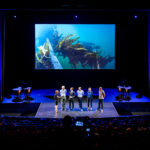Rain had been coming off and on throughout the week, and Thursday night’s forecast wasn’t looking good. Which meant that the culmination of the entire program, the centerpiece production in which President Obama accepted his party’s nomination, wasn’t just going to have to be moved. It would need to be downsized. Drastically.
The idea had been to echo Obama’s triumphant acceptance speech at the 2008 DNC in Denver, when he bucked tradition and took the stage outside, before a crowd of 84,000 people at Invesco Field at Mile High stadium. In Charlotte, N.C., this year, the Democratic National Convention Committee (DNCC) was going to use 74,000-seat, open-air Bank of America Stadium for the big speech, until the threat of rain necessitated a relocation to the 20,000-seat Time Warner Cable Arena, which had been home to the 2012 DNC’s proceedings throughout the week.
For the DNCC, it was a high-profile decision with potentially major political ramifications, because the organization had repeatedly promised to make the 2012 DNC the most “open and accessible” political convention in history. But for the meeting professionals working behind the scenes, it was just another day at the office. “There was always a Plan B if [the acceptance speech] were to stay within the arena,” said Ron Bracco, executive director of business development for events for Hargrove Inc., the 2012 DNC’s general services contractor. It was Thursday night, a few hours before Obama’s speech, and Bracco, the Hargrove executive in charge of the DNCC contract, was sitting with Convene in his company’s hospitality lounge at Time Warner, relaxed and smiling.
Yes, smiling. “There was always the sense that if rain was an issue or weather was an issue, that the third night would be kept here,” Bracco said. “A lot of the assets were planned to move from Time Warner Cable Arena on Wednesday night to the stadium. The fact that we are not moving those – we are not doing the fast transitions, the fast changeovers – made the process a little easier.”
AN OPEN INVITATION
In some ways, the modern political convention is a planner’s dream, because, as an event that’s designed and built for prime-time television, it’s rigidly scheduled and ruthlessly scripted. While the ostensible purpose of the DNC is to officially nominate the Democratic Party’s candidate for president, there hasn’t been an actual contested vote – in which the candidate being nominated wasn’t locked in before the convention – since 1980, when Jimmy Carter was challenged by Edward Kennedy. Today, the true purpose of the convention is to launch the candidate’s final, two-month push to Election Day with as many telegenic moments and as few surprises as possible.
“Our job is to really build that framework for the campaign to forward its message into,” Theo LeCompte, the DNCC’s chief operating officer, said in an interview a month before the 2012 DNC. “Some of the things that we have to do each cycle provide some of that framework, but I think that you’ve seen by what we were able to do in Denver that there is this ability to go completely outside the box and invite so many more people into the process and do something that’s so new and so different [but] still in a structure that’s been around for a long time.”
The theme of the 2012 DNC was “Americans Coming Together,” and the DNCC was determined to make that as literally true as possible, with a variety of programs that involved Democratic Party volunteers and the general public, in addition to party delegates and officials. “We engaged Americans in conversation about what we could do to make this their convention,” said Comelia Sanford, the DNCC’s director of convention operations for the Charlotte Convention Center, which served as the media center and also hosted caucus and council meetings. “The response from the public was emphatic, that they wanted more ways to participate.”
The 2012 DNC’s organizers heard them. Convention week kicked off on Labor Day, Sept. 3, with CarolinaFest 2012, a free, “family-friendly celebration” presented by the Charlotte in 2012 Convention Host Committee in the heart of downtown, along a four-block stretch of Tryon Avenue right next to the convention zone. About 30,000 people attended CarolinaFest, which included music performances by James Taylor and Jeff Bridges, food vendors, games and crafts, and free admission to the museums falling within the event perimeter.
During the official run of the DNC – Tuesday, Sept. 4, through Thursday, Sept. 6 – access to the venues was carefully controlled via a system of pedestrian barriers and security checkpoints, but still there were numerous opportunities for the general public to participate. The caucus and council meetings at the convention center were open to anyone who registered in advance, space permitting, and each night there were “watch parties” along Tryon Avenue, with wide-screen TVs broadcasting the action happening on stage at Time Warner.
Inside the arena – which hosted the bulk of the convention’s business, from platform amendments to roll-call votes – the DNCC made sure that the live program itself was more accessible. Whereas at past conventions it placed the stage in the center of the floor, “sort of the equivalent of the hockey middle-ice line,” LeCompte said, “this time we’ve put the stage down in the end zone, much more similar to the way you would for a standard concert. This allows us to preserve more seats and allow more people into the facility.”
Until the weather forced a change in plans, the 2012 DNC’s open-arms approach was going to culminate on Sept. 6 in a full-day program at Bank of America, with “performers, speeches, and everyday Americans all part of the program,” Alan Fitts, the DNCC’s director of stadium operations, said about a month before the convention. “So programming will go on throughout the day. I don’t have a start time yet, but we expect crowds to be flowing in from early in the morning all the way until the president speaks.”
The rain that washed those plans away actually dogged the 2012 DNC throughout the week, including during CarolinaFest. But it did nothing to dampen the inclusive, festive atmosphere of the convention. Wednesday morning offered a typical scene: The sky was cloudy but still bright, and crowds flowed steadily along College Street, from the convention center up toward Time Warner and back. Delegates, campaign workers, politicians, activists, volunteers, media people, police, and, it seemed, everyday citizens of Charlotte bumped past each other on the sidewalk, where vendors hawked t-shirts, posters, pins, buttons, sunglasses, caps, and other Obamanalia. A lanyard swung from almost everyone’s neck, inside and outside the venues, which only deepened the sense of being at a reunion where a fair number of the attendees just happened to be meeting for the first time.
The only discordant note came from a vigil of antiabortion protesters broadcasting a steady harangue at the entrance to the convention center, but even that didn’t seem terribly out of place. Nor did a group from Code Pink situated farther up College Street late that afternoon, wearing hot-pink feather boas and black top hats, chanting: “RNC! DNC! It’s all part of the oligarchy!” Because of course there would be protesters at a political convention determined to welcome everybody.
“There are about one thousand special events that go on during the convention – corporate parties, delegate events, that sort of thing,” said Mike Butts, executive director of Visit Charlotte, sitting at a window on the second floor of the convention center, overlooking the hustle and bustle on College Street. “Typically, if you work with a major convention, you might work with two or three different venues. This is working with hundreds of venues. That took active work in getting them engaged in the process, asking them to hold onto their space while the DNC started to collect requests from different entities on wanting to be able to do special events. That was a little unique and something different.”
MOVING IN, BUILDING OUT
For Visit Charlotte’s fellow meeting professionals at Hargrove, the 2012 DNC was also something unique and different. The Latham, Md.–based company has worked on plenty of high-profile events – including every presidential inaugural since Harry S. Truman’s in 1949, and this year’s NATO Summit in Chicago and G-8 Summit at Camp David – but this was its first political convention. And it was as hugely complicated a job as you’d imagine: Hargrove literally built the “framework for the campaign to forward its message into” that LeCompte described, managing construction at Time Warner, Bank of America, and the convention center.
“In the build-out of [the three venues], it is really looking at how we retrofit space for the needs of the DNCC as well as the media, and the production needs as well,” Bracco said, speaking by phone from Charlotte during an interview before the convention. “We are looking at how we pull cable through the space, how we brand the buildings, how we design signage in a way that the attendees can easily get around the space and such.”
Walking through Time Warner with Bracco during the DNC two weeks later, you could see just how involved all that was – and why previous conventions have tended to use construction companies to run the process. It was Wednesday night, and we were on the Founders Level, whose ring of private suites was mostly occupied by news networks and other media organizations. The DNCC had received the keys to the arena on July 16, and, working with construction and architecture companies, Hargrove had spent the month and a half since then refitting the entire facility. A track with row upon row of data cables was bolted into the hallway ceiling; sharp corners were capped with hard foam bumpers; power cords were taped down everywhere. Inside some of the suites, cabinets and countertops and seats had been taken out to make room for broadcast equipment and anchor stations.
“Back in December,” Bracco said, “there was a media walkthrough: ‘Here is the arena. Here is what we are proposing would be positions for cameras and studio suites, and here is tentatively the location of the stage.’ And three months later, there was another media walkthrough: ‘Here is what we have learned, and here are the services that we may be able to provide. Here is where your support satellite trucks may be,’ and such.”
And that was just at Time Warner. At the convention center, the lower-level exhibit halls had to be outfitted to accommodate about 15,000 media professionals, which meant a veritable city of temporary office space. “In a construction mindset, you need to build a wall,” Bracco said. “That means steel goes up and drywall goes on, and it becomes a construction site. Some of that is absolutely necessary, but in our scenario [as an event-services company], we thought through a blend of services, so that we are not actually building every little wall or corner or masked area that is not necessary. This convention is a blend of pipe and drape, modular wall systems that you see in convention services, and, only where necessary, stud walls, ceilings, and fireproofing and sprinkler systems – when the rooms needed to be secure and soundproofed.”
Work at Bank of America started much later, at the end of August – and, it turned out, would be for naught, thanks to those rains. Hargrove started breaking down the stadium on Wednesday, as soon as the decision was made to move the final program to Time Warner. On Thursday night, with Hargrove’s hospitality lounge filling up with clients, staff, and guests, Bracco was philosophical. “I think the biggest thing for us, and we are working through it now, is there was a request for additional cabling – fiber – to run from here to provide a feed to the convention center,” he said, “so [the DNCC] could do large watch parties at the convention center [for people who had tickets for Bank of America]. And most of the tracks were already laid, so it is a mad dash to run cables. And even that was not terribly surprising or difficult.”
Breakdown at Time Warner would begin that night, after the convention was over, and the DNCC would turn the building back over to the city of Charlotte on Sept. 26 – completely restored to its former state. Bank of America needed to be back in shape for a Carolina Panthers home game on Sept. 16. And at the convention center, Sanford said, there would be “three or four days” to move out. It takes four years to build a political convention, and a few weeks to unbuild one.
“It’s always a challenge to put together an event where you have so many different groups of people coming in,” LeCompte said. “You’ve got the media, you’ve got delegates, you’ve got folks from the campaign. Balancing the different needs to different groups is always a challenge in any setting. And it’s certainly one we embrace here at the convention. We spend a lot of time focusing on making sure that we get all the convention attendees exactly what they need in order to do their job or to have fun. Whatever their goal happens to be.”
MORE RESOURCES
› To learn more about the 2012 Democratic National Convention, visit demconvention.com.
› For more information about the Charlotte in 2012 Convention Host Committee, visit charlottein2012.com.



